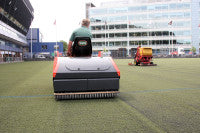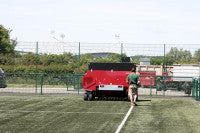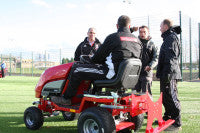Artificial pitch maintenance - who, how, when and why?
 The importance of maintaining artificial turf pitches is widely acknowledged throughout the sports industry, and the consequences of neglecting to do so have been well-documented. But, when it comes to the fundamentals, the practicalities of actually looking after your own artificial sports surface, where do you start?
The importance of maintaining artificial turf pitches is widely acknowledged throughout the sports industry, and the consequences of neglecting to do so have been well-documented. But, when it comes to the fundamentals, the practicalities of actually looking after your own artificial sports surface, where do you start?
Nick Harris from Technical Surfaces Ltd analyses the finer points of maintenance, helping you to generate maximum use, performance and revenue from your artificial sports facility
A key motivation when choosing an artificial pitch, ahead of its natural counterpart, is the increased playability it allows, and the potential revenues that can be generated as a result. However, unless you implement a maintenance programme directly proportionate to the benefits you are hoping to achieve, you could find yourself in something of a Catch-22 situation; with a pitch that is in such poor condition from lack of maintenance that nobody wants to hire it. Yet, without the income from letting your pitch, you cannot afford the specialist deep-clean that will restore its condition and playability, and thereby encourage bookings.
Your artificial turf pitch represents a substantial investment, purchased with a view to lasting between ten and fifteen years and, as such, demands a maintenance programme that reflects the value of your asset.
 So, how do you set about establishing a good routine of regular, effective maintenance that will enable you to realise the potential benefits afforded by an artificial sports surface - principally, maximised revenue, year-round availability and a prolonged surface life?
So, how do you set about establishing a good routine of regular, effective maintenance that will enable you to realise the potential benefits afforded by an artificial sports surface - principally, maximised revenue, year-round availability and a prolonged surface life?
For new-build facilities, a good starting point will be the guidelines laid out in the manufacturer's guarantee, which will help you to identify the daily, weekly and monthly maintenance requirements of your artificial pitch. Aside from recommending best practice, an approved maintenance programme is intrinsically tied to the manufacturer's guarantee; failure to properly maintain your pitch will often invalidate your warranty.
Your pitch installer will detail a set of maintenance duties that must be performed (and logged); from basic inspections, litter picking, leaf collection and brushing, through to mechanical sweeping, infill top-ups and decompactions. They should also give advice on the most appropriate machinery and equipment to use to enable these tasks to be completed.
Of equal influence when deciding how to approach the maintenance needs of your artificial pitch are more practical considerations, such as available budgets,  performance requirements and proposed usage levels, together with the resources at your disposal (time, money, expertise) that you will need to sustain your pitch at a consistently high quality throughout its life.
performance requirements and proposed usage levels, together with the resources at your disposal (time, money, expertise) that you will need to sustain your pitch at a consistently high quality throughout its life.
It is important to remember that a maintenance programme can be introduced at any stage in the life cycle of an artificial pitch, although the benefits are always most apparent when introduced from day one. That said, there are specialist services available from pitch maintenance companies which, when supplemented by a continued programme of regular maintenance, can add a further five years' use to an older pitch that might otherwise be considered beyond repair.
So, having identified the essentials of maintaining your artificial pitch, the next task is to assign the responsibility to a dedicated team, be it your in-house groundstaff or outsourced to a specialist contractor. Again, any decision-making will be governed primarily by constraints on time, funds and knowledge, so you will need to adapt your maintenance regime accordingly.
You could choose to project-manage the full maintenance requirements of your artificial pitch in-house. To do this correctly requires a large initial budget (in the region of £20,000) in order to purchase a suitable machine. There are a select number of specialist manufacturers in the industry, whose machinery has been modified from the technology used to develop grass-cutting and floor-cleaning equipment.
 As advancements continue to be made in the science behind artificial turf, so too does the machinery required to maintain it evolve to cope with the latest innovations. These machines are especially versatile, and designed to carry out a wide range of maintenance functions; from the everyday - regular brushing, leaf removal, chemical spraying - to the more advanced (decompaction, infill top-ups, deeper cleaning). This option would be suitable for councils or facility management companies, charged with maintaining multiple pitches at a number of sites, but it is always worth stressing the importance of operator knowledge and experience. If purchased through a specialist maintenance contractor, you should be able to arrange for training on the correct usage of your machinery and its attachments.
As advancements continue to be made in the science behind artificial turf, so too does the machinery required to maintain it evolve to cope with the latest innovations. These machines are especially versatile, and designed to carry out a wide range of maintenance functions; from the everyday - regular brushing, leaf removal, chemical spraying - to the more advanced (decompaction, infill top-ups, deeper cleaning). This option would be suitable for councils or facility management companies, charged with maintaining multiple pitches at a number of sites, but it is always worth stressing the importance of operator knowledge and experience. If purchased through a specialist maintenance contractor, you should be able to arrange for training on the correct usage of your machinery and its attachments.
The one procedure that cannot be completed using this type of machinery, however, is infill extraction and replacement - a highly specialised process typically required later in the life cycle of an artificial pitch, when draining capabilities have failed.
Regular brushing and mechanical removal of leaf and tree debris, dirt, detritus and broken-down carpet fibres will help to minimise contamination levels, if administered at appropriate intervals throughout the life of an artificial pitch but, ultimately, whether it is the result of insufficient maintenance practices or simply the age of the artificial turf itself, the likelihood is that water will eventually fail to drain away completely.
When this happens, you will be faced with either resurfacing your artificial pitch or replacing the contaminated infill by means of a specialist deep-cleaning service that  is only available from dedicated pitch maintenance experts. Replacing the artificial pitch before it is has reached its full life expectancy is an economically redundant decision, and represents a poor return on your initial investment. Yes, resurfacing is a certainty with an artificial pitch, but there are services available that can help to delay the inevitable, from which you may not benefit if you choose to complete all your maintenance work in-house.
is only available from dedicated pitch maintenance experts. Replacing the artificial pitch before it is has reached its full life expectancy is an economically redundant decision, and represents a poor return on your initial investment. Yes, resurfacing is a certainty with an artificial pitch, but there are services available that can help to delay the inevitable, from which you may not benefit if you choose to complete all your maintenance work in-house.
Another potential pitfall to the 'do it yourself' option is the hidden cost involved - of labour, of servicing, operating and maintaining the machinery, and of ordering replacement parts when things go wrong.
Furthermore, experience tells us that it can encourage a more 'reactive' attitude to pitch maintenance requirements, with tasks such as brushing, sweeping and leaf collection simply 'fitting in' around pitch usage. Dedicated maintenance timeslots should be allocated on a daily and weekly basis (even during school holidays), whilst artificial pitch maintenance practices, as a whole, should follow the adage that 'prevention is better than the cure'.
So, if you lack adequate funds and capabilities to tackle the full remit of artificial pitch maintenance yourself, should you, instead, hand over full responsibility to a specialist contractor?
By comparison, this is certainly the most hassle-free way of ensuring that your pitch is maintained correctly, particularly if implemented from day one. It affords a level of consistency and continuity that can otherwise be found lacking, and regular inspections and reports provide a ready-made audit trail required for warranty purposes.
Monitoring and reporting can also help to identify any defects or issues with the structural condition of the surface. Where groundstaff might lack the confidence or experience to diagnose the problems that could affect an artificial pitch's playability, drainage or even safety, a specialist contractor can assume responsibility. After all, such a substantial investment deserves to be maintained properly, so who better than the experts to take care of everything?
Well, at first glance this would be an ideal scenario (as much for us maintenance companies as for our customers) but, in reality, it is neither the most economical nor practical way to look after your artificial pitch.
 The most fundamental operations are daily and weekly duties; regular brushing, dragging, litter picking and leaf collection, all of which require minimal time and effort. By completing this work in-house, rather than outsourcing it to a contractor, you can dramatically reduce your spending, freeing up additional funds for more specialist procedures.
The most fundamental operations are daily and weekly duties; regular brushing, dragging, litter picking and leaf collection, all of which require minimal time and effort. By completing this work in-house, rather than outsourcing it to a contractor, you can dramatically reduce your spending, freeing up additional funds for more specialist procedures.
It would also be prudent to ensure that you have selected the right company to look after your artificial pitch. Beware of the landscaper professing to include your artificial pitch as part of an overall grounds maintenance package; practices suitable for natural turf do not transfer well to an artificial sports pitch. Indeed, it is a common misconception that little or no expertise is required to maintain artificial sports pitches. True, a different set of skills are required, but they are skills nonetheless, and a poor understanding of the maintenance requirements of an artificial pitch can be detrimental to its long-term viability.
This leaves us with a third and final option to consider; a combination of in-house and specialist maintenance.
Where possible, you should utilise the resources available to you within your grounds team, and invest in some suitable machinery to undertake everyday maintenance tasks, whilst outsourcing the more costly, specialist works to a suitable maintenance provider.
They should be able to recommend and supply appropriate equipment (such as a tractor, small brush, dragmat) to carry out daily and weekly brushing, dragging and raking of your pitch, along with adequate training and demonstrations. A budget of around £5,000 should enable you to purchase a machinery package that is simple, easy to use, reliable and, above all, affordable.
This can then be complemented with regular sweeping, vegetation treatments, decompactions, infill top-ups, deep-cleaning and repair works by your contractor.
If you are assuming that the outsourced maintenance of your artificial pitch will cost less to maintain than a natural grass surface, then you could well be disappointed. However, an annual budget in the region of £7,500 should provide you with a comprehensive maintenance service that will help to enable your pitch to be used for around forty-five hours a week, which equates to approximately £3.20 for every hour that the pitch is in use*.
This emphasises the key point that effective maintenance can actually be implemented at a fraction of the cost of the revenues that can be generated from the increased playability of artificial sports pitches.
The key to the success of a combined maintenance effort is communication; a shared knowledge and continued dialogue between the pitch owner and their maintenance provider ensures that any issues can be identified at an early stage, and rectified before they worsen, with potential implications for the pitch's overall playing quality and its economic viability.
A programme of routine and specialist maintenance throughout the life of an artificial pitch can help to ensure its longevity and safety, as well as preserving its aesthetics and performance levels.
For pitch owners and operators, the warranty implications of carrying out incorrect, or no maintenance, are serving to promote a greater understanding of the importance of a dedicated maintenance programme, to the useable life of their artificial surface. Exactly how that maintenance is implemented depends on key indicators, primarily available funds.
In our experience, working together with your maintenance contractor provides the most economical way to establish a programme of works that falls within your budget, whilst covering the essential processes needed to keep your pitch in good condition.
As with natural grass, time and effort is required to effectively maintain an artificial pitch, and the necessary knowledge of the construction and maintenance requirements of these facilities should form part of any grounds team's skill set.
For every ten hours of use on an artificial pitch, one hour should be allocated for maintenance and, if you follow this rule from day one, a successful maintenance programme can help you maximise the return on your investment and enjoy many years of use from your artificial sports pitch.
*Data extracted from 'Maintenance Cost Benefits', Dr. Colin Young, SAPCA (03.04.2009 SportSurf, Loughborough University)
